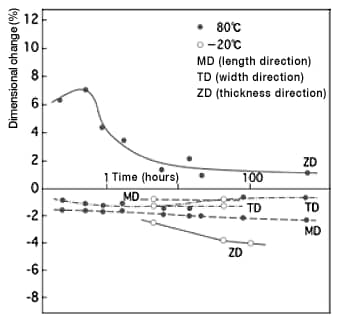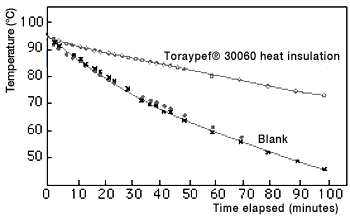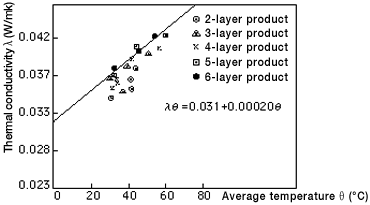- HOME
- Technical Information
- TORAYPEF™ Polyolefin Foam
- Excellent heat insulation
Excellent heat insulation
Thermal properties
Ⅰ. Usable temperature range for TORAYPEF™
TORAYPEF™ is cross-linked using electron beam, so it can be used in a broader range of temperatures than products having no cross-linking. The ambient operating temperatures for TORAYPEF™ depend on the purpose of use, so no blanket statements can be made. However, about 80°C is the maximum temperature suitable for continuous use, from the perspective of appearance or dimensions. However, TORAYPEF™ may be used in temperatures above 100°C under certain conditions or for short durations of time. According to bending-test (Mandrel bending test) results, brittle failure occurs at temperatures between -70°C and -100°C, with some variation depending on the grade. That is a remarkably low brittle-failure temperature, in light of the fact that polystyrene foam exhibits brittle failure near room temperature. TORAYPEF™ is well-suited for cold-insulation applications, such as refrigerated warehouses and brine pipes, and is even used to cold-insulate at -196°C (the temperature of liquid nitrogen). Heat-resistant grades of polypropylene can be used continuously at temperatures up to 120°C, but are inferior to polyethylene grades in terms of resistance to cold and exhibit brittle failure at around -20°C in low-temperature bending tests.
Ⅱ. Dimensional change
Figure 1 shows the dimensional change curve of TORAYPEF™ at -20°C and 80°C. Heat causes some shrinkage in the length and width directions and swelling in the thickness direction, but only to a slight extent up the continuous operating temperature for TORAYPEF™ of 80°C. Cooling causes shrinkage in all directions—length, width and thickness—due to a decline in gas pressure within the foam cells. However, the extent of shrinkage is even smaller than in the case of heating, because the resin that makes up the foam cell walls becomes more rigid.

Dimensions measured after leaving samples in a standard state for one hour after heating at 80°C.
For the -20°C temperature, dimensions were measured in a low-temperature chamber.
Figure 1: TORAYPEF™ (30060) dimensional change curve
Ⅲ. Coefficient of linear expansion
A sample that is in a state of equilibrium at 23°C was placed in a low-temperature chamber at -20°C. After reaching shrinkage equilibrium, the dimensions of the sample were measured. The results of linear expansion coefficient measurements are shown in the Table of General Properties of Major TORAYPEF™ Grades. For TORAYPEF™, that coefficient is about 10-3 to 10-4/°C, with some variance by grade, far from the levels exhibited by metal or wooden materials (for example, copper is 1.14×10-5/°C). However, in actual heat-insulating applications, TORAYPEF™ would be bonded to a wall surface and fixed in that position, so TORAYPEF™ would not be a hindrance in any practical way, given its high elasticity limit.
Ⅳ. Heat-insulating properties
TORAYPEF™ boasts superb heat-insulating properties, thanks to the high volume of air contained within its closed-cell microstructure. For example, the periphery of a 3-liter narrow-mouth glass reagent bottle was covered completely with TORAYPEF™ 30060. Then, the bottle was filled with boiling water, inserted into a 1°C low-temperature chamber. The change over time of the water temperature was measured. The results are shown in Figure 2. The decline in temperature in the bottle covered with TORAYPEF™ is minimal compared to a bottle provided no heat insulation whatsoever.

Dimensions measured after leaving samples in a standard state for one hour after heating at 80°C.
For the -20°C temperature, dimensions were measured in a low-temperature chamber.
Figure 2: Heat-insulating effects (Outside air temperature θ0 = 1°C)
Figure 3 shows the results from measurements of heat conductivity of a TORAYPEF™ 30060 heat-laminated product, measured using the guarded hot plate method (JISA 1412). The line graph (θ - λ line graph) represents the relationship between average temperature and thermal conductivity. Thermal conductivity measurement results for other grades are shown in the Table of General Properties of Major TORAYPEF™ Grades.

Figure 3: Relationship between temperature and thermal conductivity in TORAYPEF™
30060 heat-laminated products
Thermal conductivity determines temperature distribution when thermal conduction is in a constant state. However, in situations where temperature changes over time (for example, outdoor air temperature), thermal dispersion κ (= λ/cρ)determines temperature distribution. A smaller thermal dispersion leads to slower response to changes in environmental temperature, so this property is of great practical importance. Table 1 compares the thermal conductivity and thermal dispersion of TORAYPEF™ 30-times expanded foam to those other cold-insulating materials. The thermal dispersion of TORAYPEF™ is one of the smallest if compared to other plastic foams with similar densities. Table 2 shows the thickness of TORAYPEF™ required to prevent dew condensation on a long roof. The K value required to prevent dew condensation can be calculated using the following formula.

Whereas:
K: Wall heat transmission coefficient (W/m2·K)
θi: Indoor temperature (°C)
θo: Outdoor air temperature (°C)
θd: Dew point temperature (°C) determined by indoor temperature and humidity
αi: Thermal conductivity of the surface on the indoor side (W/m2·K)
Once you find the K value, you can calculate the heat-insulating material thickness required to

Whereas:
d: Thickness of the material comprising the wall (m)
λ: Thermal conductivity of the material comprising the wall (W/m·K)
αο: Thermal conductivity of the surface on the outdoor side (W/m2·K)
Please contact us if you need more information on calculating heat insulation and condensation prevention.
| Type | Apparent density (kg/m3) | Specific heat c (×102kgK) |
Thermal conductivity λο (W/mK) |
Thermal dispersion χ (m2/h) |
|---|---|---|---|---|
| TORAYPEF™ (30 times foam ratio) | 33 | 23.0 | 0.031 | 15×10-4 |
| Glass-wool | 20 | 8.4 | 0.0×35 | 7510-4 |
| Polystyrene foam | 20 | 13.4 | 0.034 | 45×10-4 |
| Hard PVC foam | 35 | 15.9 | 0.037 | 33×10-4 |
| Phenolic foam | 35 | 15.9 | 0.031 | 20×10-4 |
| Concrete (for reference) | 2200 | 8.8 | 1.5(20°C) | 28×10-4 |
| Indoors | Near roof | Dew point θdh (°C) |
TORAYPEF™ required thickness | (mm) | |||||
|---|---|---|---|---|---|---|---|---|
| Outdoors temperature θο (°C) | ||||||||
| Temperature θi (°C) |
Humidity θ (%RH) |
Temperature θn (°C) | Humidity ψh (%RH) |
-5 | -10 | -15 | -20 | |
| 10 | 50 | 12.8 | 42 | 0.1 | 0.3 | 1.8 | 3.2 | 4.6 |
| 60 | 50 | 2.7 | 1.6 | 3.4 | 5.2 | 7.0 | ||
| 40 | 58 | 4.5 | 3.0 | 5.2 | 7.3 | 9.5 | ||
| 80 | 67 | 6.7 | 5.8 | 8.7 | 11.7 | 14.6 | ||
| 15 | 50 | 18.7 | 40 | 4.5 | 1.3 | 2.6 | 3.9 | 5.1 |
| 60 | 47 | 7.2 | 2.7 | 4.3 | 5.9 | 7.4 | ||
| 70 | 55 | 9.5 | 4.6 | 6.5 | 8.5 | 10.4 | ||
| 80 | 63 | 11.7 | 7.5 | 10.0 | 12.6 | 15.2 | ||
| 20 | 50 | 24.6 | 38 | 9.1 | 2.2 | 3.3 | 4.5 | 5.7 |
| 60 | 46 | 12.0 | 3.8 | 5.2 | 6.6 | 8.0 | ||
| 70 | 53 | 14.1 | 5.5 | 7.2 | 8.9 | 10.6 | ||
| 80 | 60 | 16.4 | 8.3 | 10.5 | 12.7 | 14.9 | ||
(Building height: 10m. using a forced-air heater)
Ⅴ. Burning characteristics
- Burn rate
The standard grade of TORAYPEF™ is flammable. The resin material itself, however, is plastic, which is highly stable when exposed to heat. TORAYPEF™ has a burn rate between 4 and 10 cm/min, depending on the grade, per ASTM D 1692 standards. Alternatively, the TORAYPEF™ FR-UL grade (Type AG20) complies with UL94HF-1.Table 3: FR4-UL grade(Type AG20)specification and property Grade thickness UL94 Horizontal burning test (Conventional)「FR3」 (New)「FR4」 AE20 type AG20 type Product Flame
RetardanceProduct Flame
Retardance30010 1㎜ Slice HF-1 Slice HF-1 30020 2㎜ HF-2 30030 3㎜ Both sides Skin Both sides Skin 30040 4㎜ 30050 5㎜ 30060 6㎜ 30080 8㎜ Laminated Both sides Skin
(Under development)30100 10㎜ - Flammable temperature and flash point
The flammable temperature of TORAYPEF™ 30060 was measured during heating in an electric arc furnace, and the flash point was measured during heating in a test tube and when subjected to a gas lighter. The results are shown in Table 3, with a comparison to soft urethane foam and a cedar plank. In terms of resistance to ignition, TORAYPEF™ was superior to soft urethane foam and comparable to the cedar plank. - Fire spread safety limit and operating radiation density
One of the causes of residential fires is spontaneous combustion caused by radiant heat. Using an infrared-light heating test, the minimum radiant density needed to ignite fire (fire spread safety limit radiant density) was measured. The results are shown in Table 3. As you can see, in any case, heating at a radiant density of even 63,000 KJ/m2hr does not spark ignition. However, at these levels of radiant density, none of the materials considered can be reused. TORAYPEF™ and urethane foam undergo significant dissolved loss caused by pyrolysis, and the cedar plank burns without flame. Using a similar method, the radiant density at which TORAYPEF™ can be reused was investigated. The result was 34,860 KJ/m2hr, a value that falls in between that for cedar plank and urethane foam.
| Category | TORAYPEF™ 30060 (30 times foam ratio, 6mm thickness) |
Soft urethane foam (Black flame-retardant sample, ρ = 0.030) |
Soft urethane foam (Black flame-retardant sample, ρ = 0.030) |
|---|---|---|---|
| Flammable temperature (°C) |
470 | 470 | 500 (Burns without ignition at 350°C) |
| Flash flammable temperature (°C) |
360 or higher | 310 | 310 |
| Fire spread safety limit radiant density (KJ/m2·hr) |
63,000 or higher | 63,000 or higher | 63,000 or higher |
| TORAYPEF* operating radiant density (KJ/m2·hr) |
34,860 | 21,000 | 54,600 |
These data are representative examples of measurement values obtained using specific conditions. The values should not be used as a standard.